Associations between sarcopenia and degenerative lumbar scoliosis in older women
- PMID: 28331906
- PMCID: PMC5356321
- DOI: 10.1186/s13013-017-0116-0
Associations between sarcopenia and degenerative lumbar scoliosis in older women
Abstract
Background: Age-related sarcopenia can cause various forms of physical disabilities. We investigated how sarcopenia affects degenerative lumbar scoliosis (DLS) and lumbar spinal canal stenosis (LSCS).
Methods: Subjects comprised 40 elderly women (mean age 74 years) with spinal disease whose chief complaints were low back pain and lower limb pain. They included 15 cases of DLS (mean 74.8 years) and 25 cases of LSCS (mean age 72.9 years). We performed whole-body dual-energy X-ray absorptiometry (DXA) to analyze body composition, including appendicular and trunk skeletal muscle mass index (SMI; lean mass (kg)/height (m)2) and bone mineral density (BMD). A diagnostic criterion for sarcopenia was an appendicular SMI <5.46. To check spinal alignment, lumbar scoliosis (LS), sagittal vertical axis (SVA), thoracic kyphosis (TK), lumbar lordosis (LL), pelvic tilt (PT), pelvic incidence (PI), sacral slope (SS), and vertebral rotational angle (VRA) were measured. Clinical symptoms were determined from the Japanese Orthopedic Association scores, low back pain visual analog scale, and Roland-Morris Disability Questionnaire (RDQ). Criteria for DLS were lumbar scoliosis >10° and a sagittal vertical axis (SVA) >50 mm. Sarcopenia prevalence, correlations between spinal alignment, BMD, and clinical symptoms with appendicular and trunk SMIs, and correlation between spinal alignment and clinical symptoms were investigated.
Results: DLS cases had significantly lower body weight, BMI, lean mass arm, and total lean mass than LSCS cases. Sarcopenia prevalence rates were 4/25 cases (16%) in LSCS and 7/15 cases (46.6%) in DLS, revealing a high prevalence in DLS. Appendicular SMIs were DLS 5.61 and LSCS 6.13 (p < 0.05), and trunk SMIs were DLS 6.91 and LSCS 7.61 (p < 0.01) showing DLS to have significantly lower values than LSCS. Spinal alignment correlations revealed the appendicular SMI was negatively correlated with PT (p < 0.05) and the trunk SMI was found to have a significant negative correlation with SVA, PT, LS, and VRA (p < 0.05). The trunk SMI was found to have a significant positive correlation with BMD (p < 0.05). As for clinical symptoms, RDQ was negatively correlated with appendicular SMI and positively correlated with PT (P < 0.05).
Conclusions: Sarcopenia complications were noted in 16% of LSCS patients and a much higher percentage, or 46.6%, of DLS patients. Appendicular and trunk SMIs were both lower in DLS, suggesting that sarcopenia may be involved in scoliosis. The appendicular skeletal muscle was related to posterior pelvic tilt, while the trunk muscle affected stooped posture, posterior pelvic tilt, lumbar scoliosis, and vertebral rotation. Decreases in trunk muscle mass were also associated with osteoporosis. Moreover, RDQ had a negative correlation with appendicular skeletal muscle mass and a positive correlation with PT, suggesting that sarcopenia may be associated with low back pain as a result of posterior pelvic tilt. Our research reveals for the first time how sarcopenia is involved in spinal deformations, suggesting decreases in pelvic/lumbar support structures such as trunk and appendicular muscle mass may be involved in the progression of spinal deformities and increased low back pain.
Keywords: Adult spinal deformity; Low back pain; Sagittal alignment; Sarcopenia; Skeletal muscle.
Figures
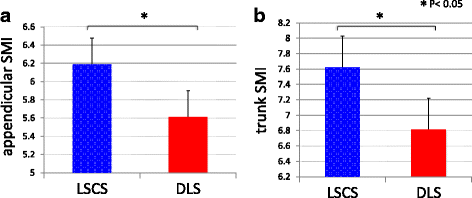
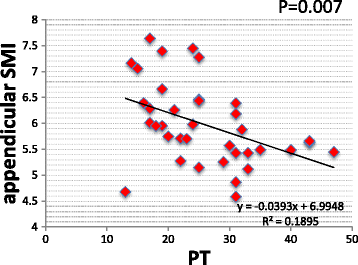
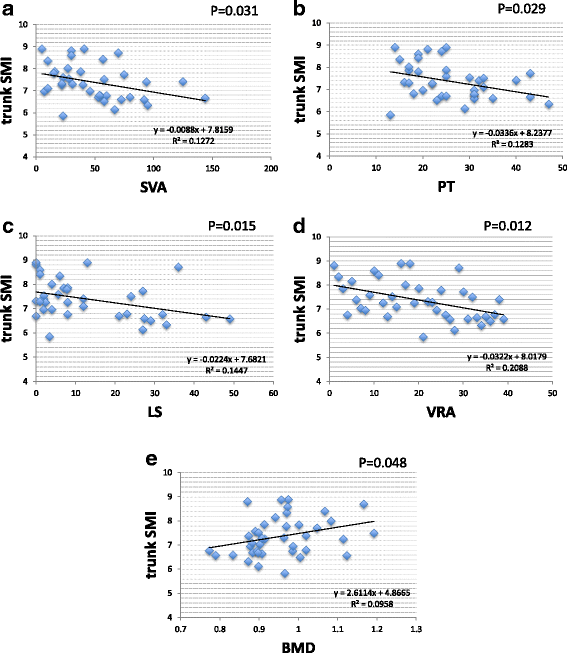
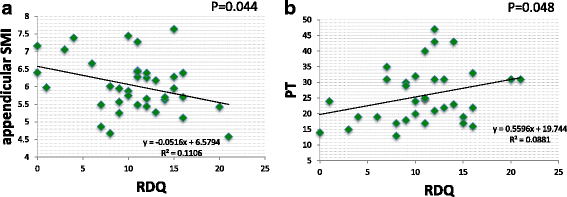
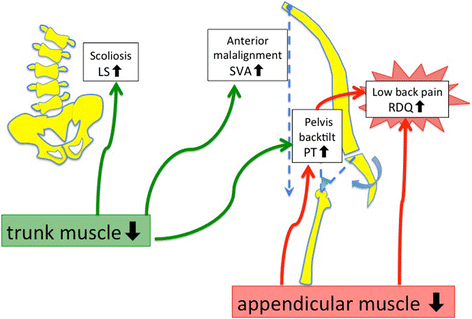
Similar articles
-
Pentosidine concentration is associated with degenerative lumbar scoliosis in older women: preliminary results.Eur Spine J. 2018 Mar;27(3):597-606. doi: 10.1007/s00586-017-5370-6. Epub 2017 Nov 10. Eur Spine J. 2018. PMID: 29127513
-
Analysis of skeletal muscle mass in women over 40 with degenerative lumbar scoliosis.Eur Spine J. 2019 Jul;28(7):1618-1625. doi: 10.1007/s00586-018-5845-0. Epub 2018 Dec 4. Eur Spine J. 2019. PMID: 30515558
-
Influence of Skeletal Muscle Mass and Spinal Alignment on Surgical Outcomes for Lumbar Spinal Stenosis.Asian Spine J. 2018 Jun;12(3):556-562. doi: 10.4184/asj.2018.12.3.556. Epub 2018 Jun 4. Asian Spine J. 2018. PMID: 29879785 Free PMC article.
-
Spinal sagittal alignment and head control in patients with cerebral palsy.J Child Orthop. 2020 Feb 1;14(1):17-23. doi: 10.1302/1863-2548.14.190160. J Child Orthop. 2020. PMID: 32165977 Free PMC article. Review.
-
D3 -Creatine dilution and the importance of accuracy in the assessment of skeletal muscle mass.J Cachexia Sarcopenia Muscle. 2019 Feb;10(1):14-21. doi: 10.1002/jcsm.12390. Epub 2019 Mar 21. J Cachexia Sarcopenia Muscle. 2019. PMID: 30900400 Free PMC article. Review.
Cited by
-
The Establishment of a Mouse Model for Degenerative Kyphoscoliosis Based on Senescence-Accelerated Mouse Prone 8.Oxid Med Cell Longev. 2022 Jul 20;2022:7378403. doi: 10.1155/2022/7378403. eCollection 2022. Oxid Med Cell Longev. 2022. Retraction in: Oxid Med Cell Longev. 2023 Sep 27;2023:9753462. doi: 10.1155/2023/9753462. PMID: 35910839 Free PMC article. Retracted.
-
Relationships Between Spinal Alignment and Muscle Mass in Osteoporosis Patients Over 75 Years of Age Who Were Independent and Maintained Their Activities of Daily Living.Cureus. 2021 May 19;13(5):e15130. doi: 10.7759/cureus.15130. Cureus. 2021. PMID: 34159032 Free PMC article.
-
A comparison of interferential current efficacy in elderly intervertebral disc degeneration patients with or without sarcopenia: a retrospective study.BMC Musculoskelet Disord. 2024 Mar 13;25(1):214. doi: 10.1186/s12891-024-07337-w. BMC Musculoskelet Disord. 2024. PMID: 38481194 Free PMC article.
-
Clinical Efficacy of Neurotropin for Lumbar Spinal Stenosis with Low Back Pain.Pain Ther. 2023 Apr;12(2):461-473. doi: 10.1007/s40122-022-00472-z. Epub 2023 Jan 16. Pain Ther. 2023. PMID: 36645650 Free PMC article.
-
Sarcopenia is related to spinal sagittal imbalance in patients with spinopelvic mismatch.Eur Spine J. 2019 Sep;28(9):1929-1936. doi: 10.1007/s00586-019-06066-2. Epub 2019 Jul 17. Eur Spine J. 2019. PMID: 31317307
References
LinkOut - more resources
Full Text Sources
Other Literature Sources
Research Materials
Miscellaneous
